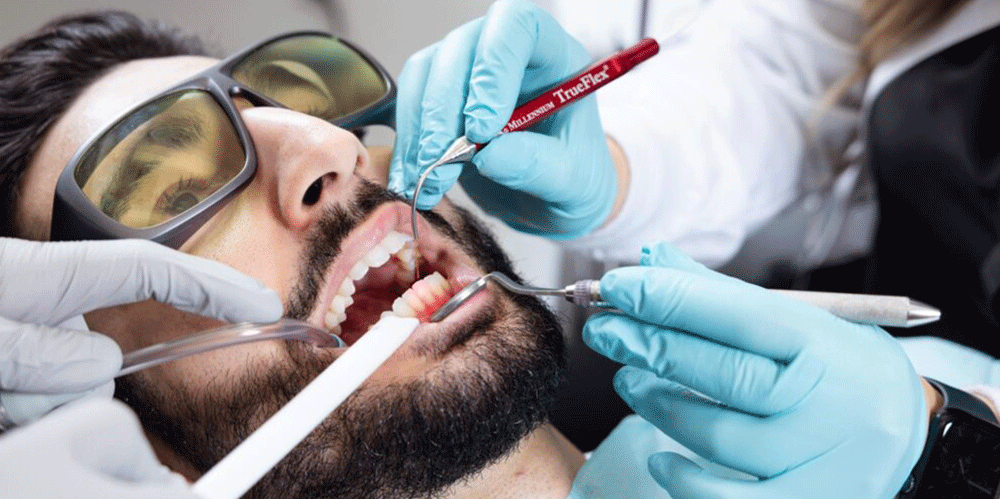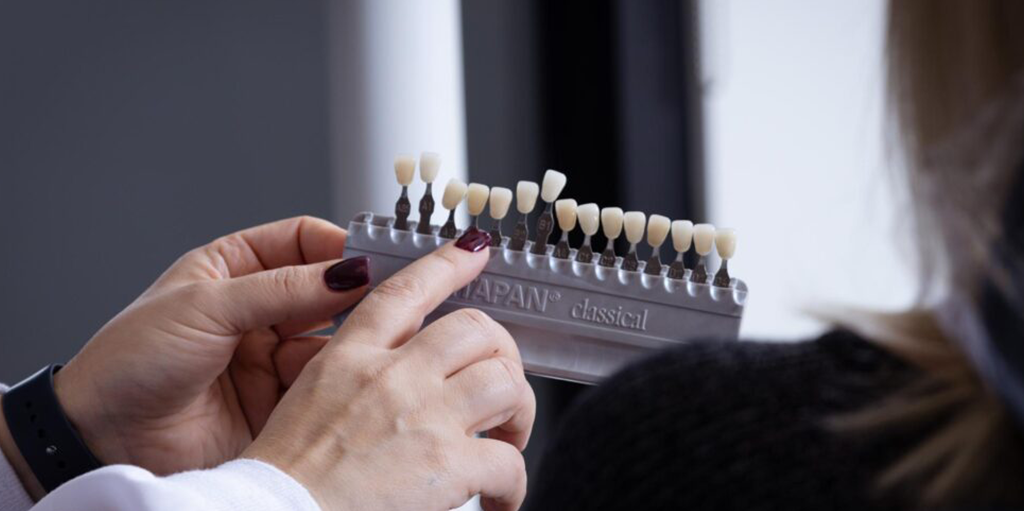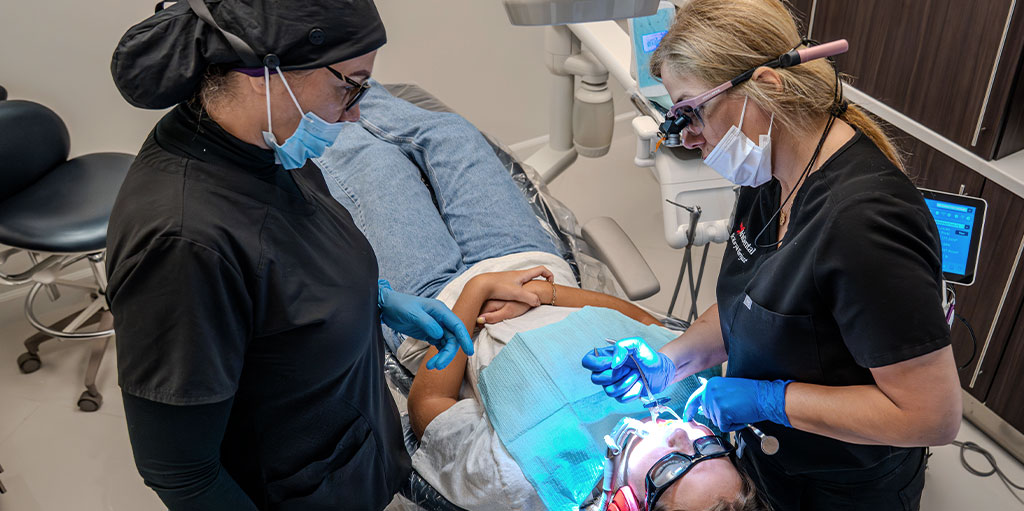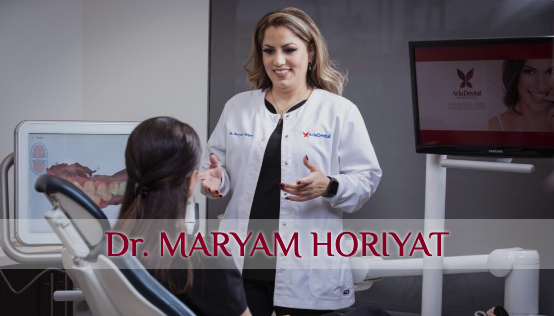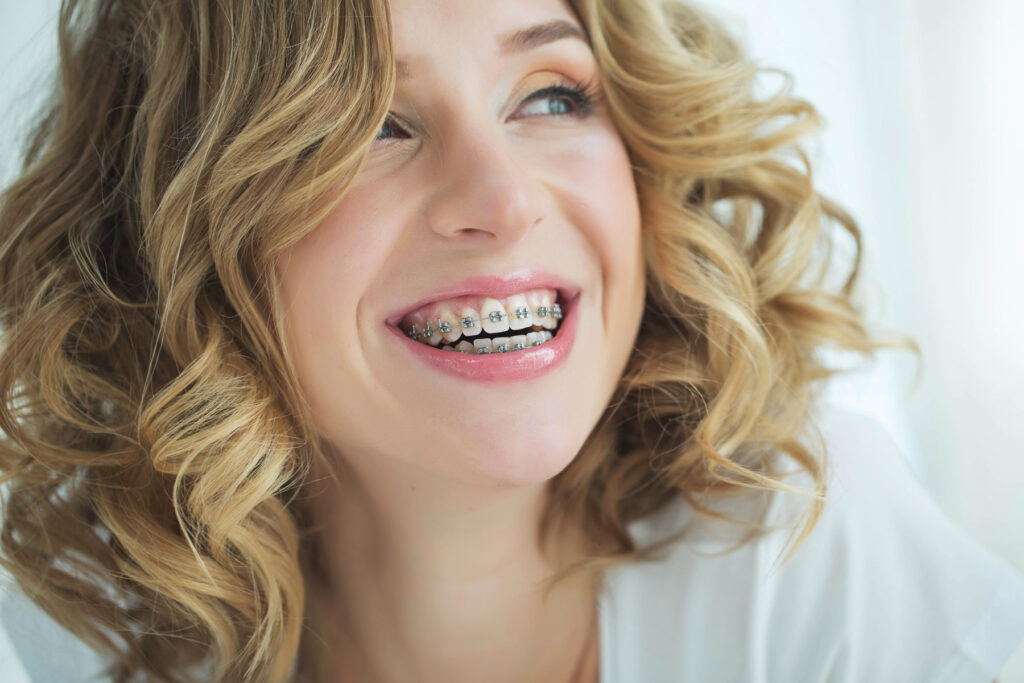When we realize that one of our teeth is severely damaged, we will definitely be worried. That’s completely normal. Teeth affect both the beauty of our appearance and are important for oral health and the overall health of the body. Without a doubt, dental implants are one of the best and most lasting solutions for missing teeth. However, various reasons, such as treatment costs, a lack of jawbone, and individual patient preferences, lead patients to consider alternatives to dental implants. If you also want to know what alternative solutions are available to you besides dental implants and what advantages and disadvantages each of them has, stay with us until the end of this article.
Dental Crown
A dental crown is a protective cap that is completely bonded to the original tooth and improves the appearance, function, and chewing ability of the tooth.
The dentists use a crown for teeth that can no longer be restored. If a tooth has too much decay, it cannot be filled, and a dental crown is used for it. Also, usually, a crown is used to protect the teeth after the root canal treatment.
A dental crown or fixed prosthesis comes in different materials. To make a crown, a dental specialist first takes an impression of the teeth, then the impression is delivered to a laboratory, and the crown is delicately made there.

Pros
If the tooth is not yet completely lost, a dental crown can be one of the best alternatives to dental implants. This method has significant advantages. Including:
- Lower cost
- Shorter treatment time
- No need for surgery
- Preservation of the tooth root
It can be said that if the tooth is damaged and part of it remains, a dental crown can be a good option.
Cons
Although dental crowns can be an alternative to dental implants, they also have some cons that you should consider:
- Not suitable for teeth that are completely missing
- Less durable and stable than dental implants
A crown is one of the alternatives to dental implants, suitable for teeth that are one step ahead of implants. If the tooth can be saved, there is no need for an implant, and a crown can meet your needs. However, if the tooth decay is too severe or the tooth is completely removed, you should use implants or other methods to replace lost teeth.
Dental Implant VS Crown
Dental implants and crowns are both used for restoring teeth, but an implant replaces the entire tooth, including its root. In holistic dentistry, the use of zirconia implants is recommended, which is more compatible with the human body. On the other hand, a crown replaces the visible part of the tooth and is used for a tooth that has had root canal treatment or still has roots, but the natural crown is damaged or decayed.
Dental Bridge
Among the alternatives to dental implants, a dental bridge is a practical procedure that can replace a single tooth or a row of missing teeth. The way a dental bridge works is that it helps you eat and speak better by filling in the space between your teeth, as well as improving the appearance of your teeth.
The artificial teeth used in a dental bridge on the upper and lower jaw are called pontics. You need one pontic for each missing tooth. Pontics are attached to the tooth next to the gap or an implant, and their shape and size are close to your own teeth.
The most common type of bridge is a traditional bridge. In this method, the dentist glues crowns to your natural teeth on both sides of the gap, and the pontic fills the space between them. Another type of bridge is a resin or Maryland bridge, which is less invasive and less expensive. This bridge model is less strong and is therefore used more often on front teeth that play a lesser role in chewing.
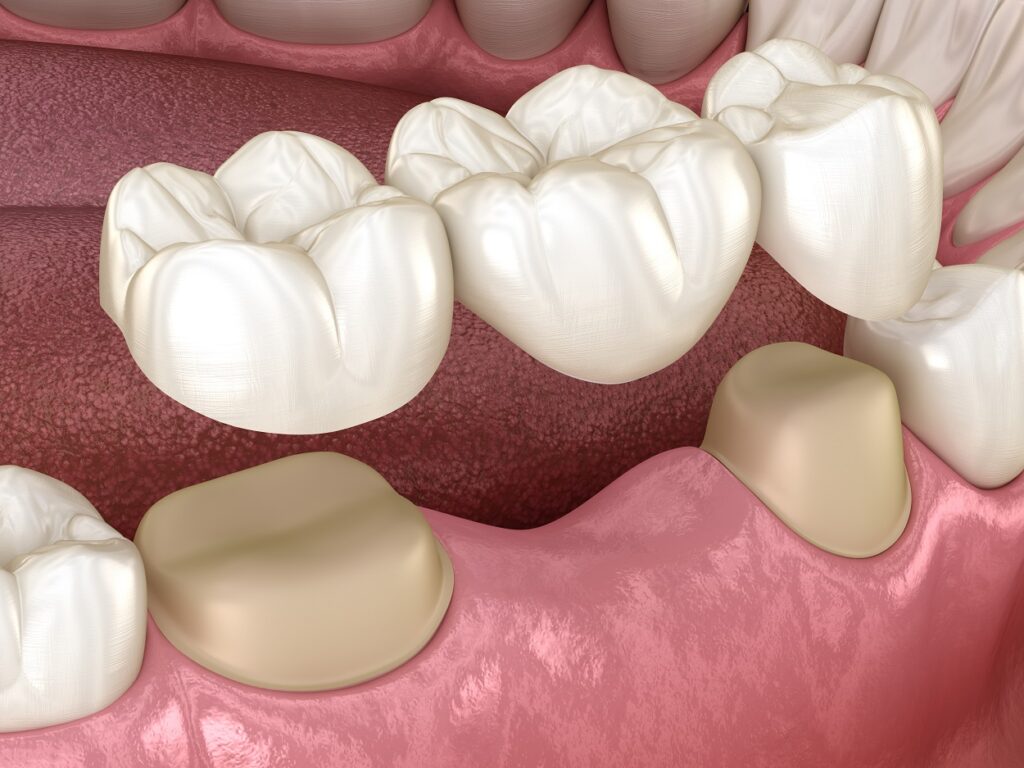
Pros
As one of the most common alternatives to dental implants, a dental bridge has significant advantages over implants.
- Lower cost
- No need for surgery
- Faster installation
Unlike crowns, this method can be used for teeth that have been completely lost and is therefore completely comparable to dental implants.
Cons
Despite the advantages we have mentioned, bridges still have significant limitations compared to implants:
- Shorter lifespan
- More difficult to care for and requires special flossing
- Looks less natural than implants
- May accelerate jawbone loss
- Traditional bridges require grinding of adjacent teeth
Implants are a more stable and longer-lasting solution than dental bridges, which also prevent jawbone loss.
Dental Implant VS Bridge
Bridges are the most well-known alternatives to dental implants. The choice between implants and bridges depends on the individual’s circumstances and needs, which should be determined by a dental professional. For example, smokers, diabetics, alcoholics, and people with immune system disorders may not be good candidates for implants.
Implants have many advantages, such as being natural, lasting longer, and performing better, but they are more expensive and require surgery. Bridges, on the other hand, are more cost-effective and don’t require surgery, but they have a shorter lifespan and are more difficult to maintain.
Implant-Supported Bridges
An implant-supported bridge is used when a patient has lost more than one tooth. In this case, one implant may be placed for every two or more missing teeth due to reasons such as insufficient bone for implants, the high cost of multiple implants, or the proximity of the tooth to nerves or the sinus cavity. An implant-supported bridge is one of the alternatives to dental implants that may also be recommended if the dentist is concerned about the excessive pressure that would be placed on multiple individual implants that are not connected.
Partial Dentures
Among all the alternatives to partial dental implants, dentures are one of the oldest methods. These are made to fit each person’s jaw and can replace all or a few teeth. One of the significant advantages of this method is its cost-effectiveness.
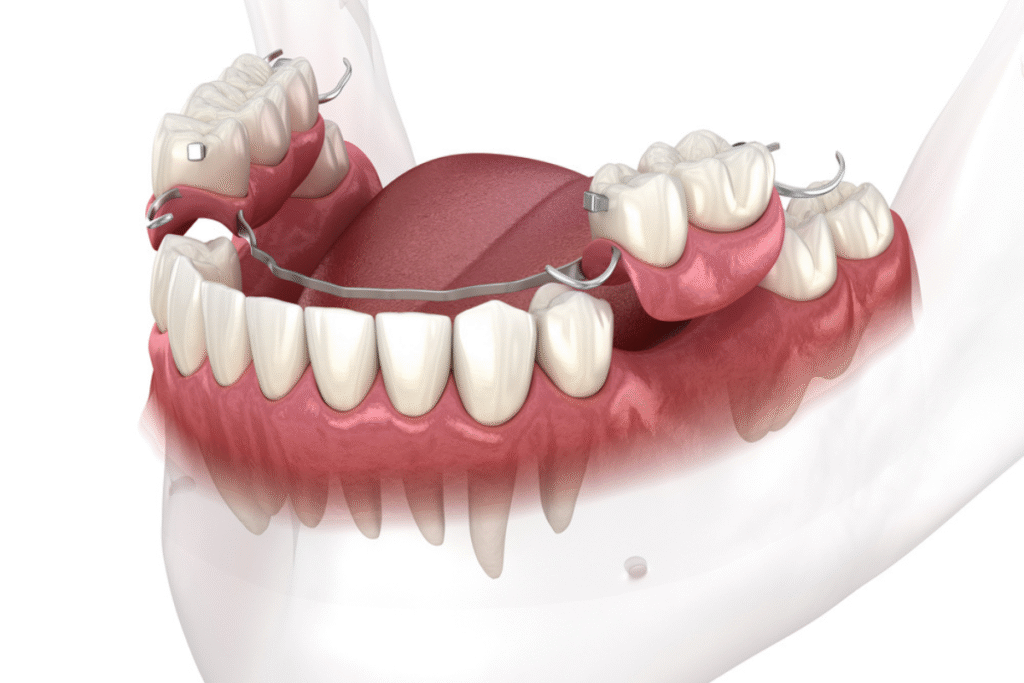
Pros
Partial dentures are placed on the gums and help people regain their facial beauty and eat easily. The following three advantages are the main reasons why people choose complete or partial dentures.
- Much lower cost
- Fast treatment
- Non-invasive and no need for surgery
Cons
Partial dentures are less stable than implants and may loosen or need to be replaced after a while. The following reasons, in addition to greater stability, make people prefer implants to dentures.
- Possibility of gum damage
- Requires special cleaning and care
- Does not prevent bone loss
- May cause changes in the taste of food
Although implants usually provide more comfortable chewing conditions and are just as easy to maintain as natural teeth, dentures are a great option as one of the least expensive alternatives to dental implants.
Dental Implant VS Partial Dentures
If you are looking for a permanent and durable solution to replace missing teeth and the cost is less important to you, dental implants are a better option. However, if you are looking for a less expensive and faster solution and are not concerned with limitations such as loosening and the need for special denture care, partial dentures can be a good option. Consulting with a professional dentist will help you make a better decision. We at Aria Dental are ready to provide you with quality and professional services.
Implant-Supported Dentures
Implant-supported dentures are a newer type of dentures, which are fixed or removable and attach to the implants. Freestanding dentures can be an alternative to dental implants. However, some people may prefer implant-supported dentures for added stability, so you may want to consider this option when making your choice.
Dental Flipper
Many alternatives to dental implants are not instant replacements for missing teeth. This is especially annoying for front teeth, which can negatively affect a person’s appearance. A flipper tooth is a removable partial denture made of acrylic that can temporarily and immediately replace missing teeth. Many people who plan to get dental implants or bridges in the future use a flipper tooth to cover the gap in their teeth before getting long-lasting solutions.
Pros
The flipper is placed on the gum and attached to the adjacent teeth with a clamp, temporarily replacing the missing teeth. The following advantages make flippers a suitable option for many people:
- Quick to prepare
- Cheaper than implants
- Does not require preparation of adjacent teeth
Flipper teeth are one of the inexpensive and temporary alternatives to dental implants that can be suitable for people who cannot use implants for any reason.
Cons
Flippers are usually considered a temporary option and can restore people to their natural beauty in a short period. In addition to their shorter lifespan, flippers have a few other disadvantages compared to implants:
- They are not durable and are not designed for heavy chewing
- They are bulky and can cause discomfort in the mouth
- Require more daily cleaning and care
- May negatively affect adjacent teeth in the long term
- Some people may be allergic to acrylic materials.
Are Veneers An Alternative to Dental Implants?
Veneers and implants are two separate treatments and are not substitutes for each other. To compare dental implants vs veneers, we need to understand that veneers are a common cosmetic dentistry treatment used to make teeth look more beautiful, remove stains, whiten teeth, correct mild crowding, chipped teeth, and unevenness of the tooth enamel surface, while implants are suitable for replacing missing teeth.
Comparing Alternatives to Dental Implants
Each of the treatments that have been introduced so far has its own characteristics, advantages, and limitations. The choice of treatment method depends on various factors, including cost, dental condition, patient preferences, and circumstances. However, in the table below, you can briefly compare the most important features of each treatment method.
| Purpose | Process | Cost | Lifespan | |
| Dental Crown | Covers and protects a damaged or decayed tooth, restoring its shape, size, and strength. | Scaling, tooth shaping, and impression, construction, placement (usually two sessions spaced one to two weeks apart) | Lower than implants | 5 to 15 Years |
| Dental Bridge | To replace missing teeth | Preparation of the base teeth, impression, construction, and placement (usually two sessions spaced one to two weeks apart) | Lower than implants | 5 to 15 Years |
| Dentures | To replace a full arch of teeth or several teeth | Impression, construction, adjustment and fitting, final installation (One to three weeks, excluding time related to tooth extraction) | Low | 5 to 10 Years |
| Dental Flipper | Temporary replacement of missing teeth (usually a few months to a year) | Examination and impression, making of initial model, making of temporary prosthesis (flipper), adjustment and installation () | Very low | A few months to a few years |
| Implant | To replace missing teeth | Implant base, abutment, and crown (between 3 to 6 months) | High | Long-lasting, sometimes permanent |
To be able to choose the best treatment method, you should consult with a specialist about all alternatives to dental implants. With years of experience and expertise, Dr. Maryam Horiyat will be with you by providing detailed information all the way from choosing the treatment method to the end of the treatment.




